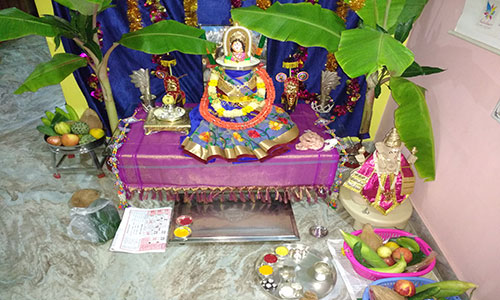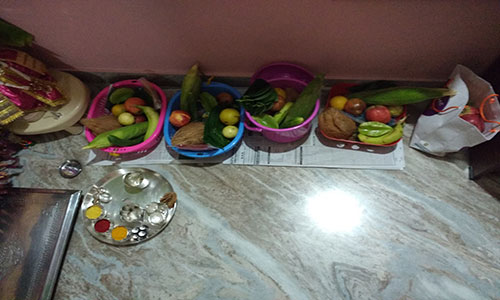On this day, Hindu women and young girls often buy new clothes and wear their traditional attire for the occasion. They make Arishinadagauri (a idol of Gowri made of turmeric) for the Puja. These days ready-made beautifully painted and decorated clay idols of Goddess Gowri can be bought along with Ganesha statues, at the market. A Mantapa is generally decorated with mango leaves and flowers. The Arishinadagauri is decorated with vastra (16 alle gejje vastra), flower garlands. A silver Kalasha is decorated with turmeric and kumkuma. The vessel filled with water has kumkum, turmeric, akshathe coin added to it.
The inner rim of Kalasha is decorated with betel leaves. A coconut is smeared with turmeric and kumkum on the mouth of the pot. Rangoli is drawn before placing the Kalasha on a plate or tray which has uncooked rice spread on it. The goddess ’arishinadagauri is mounted in a plate decorated with flowers, and ladies get their ‘gauridaara’ (a sacred thread with 16 knots ) tied to their right wrists, as blessings of Gowri and as part of the vratha. As is customary, we first worship the Ganesha idol before any other pooja. For goddess Gowri, we start with Gowri ashtotra, narrate or read the story of Gowri, do the ‘Mangalrathri’ and take the blessings of goddess Gowri.
At least 5 baginnas are prepared as part of the vratha. Each baginna usually contains a packet of arshina (turmeric), kumkuma(vermilion) , bangles, black beads (used in the mangalsutra), a comb, a small mirror, bale bicchole, coconut, blouse piece, 5 types of fruits, 5 types of vegetables. Dhaanya (cereal), rice, tur dal, green dal, wheat or rava and jaggery cut in a cube form. The baginna is offered in a traditional mora (winnow painted with turmeric). One such bagina is offered to Goddess Gowri and set aside. The remaining Gowri baaginas are given to married women.
Another specialty of this festival is that the ‘tavaru maneyavaru’ (the married woman’s parents or brothers) send money as representation of mangaladravya or sarees as gifts.
In South India sweet like Obattu, payasa, chitranna and Bajji, Kosumbari are prepared and offer to the family and friends gather for a traditional. It continues to the next day with the celebrations for Lord Ganesha’s Festival.
 Goddess Gowri
Goddess Gowri
 Swarna Gowramma
Swarna Gowramma
 Gowri Ganesha
Gowri Ganesha
 Gowri Baginna
Gowri Baginna
It has resourceful information for people who are planning to return to India
Know more
